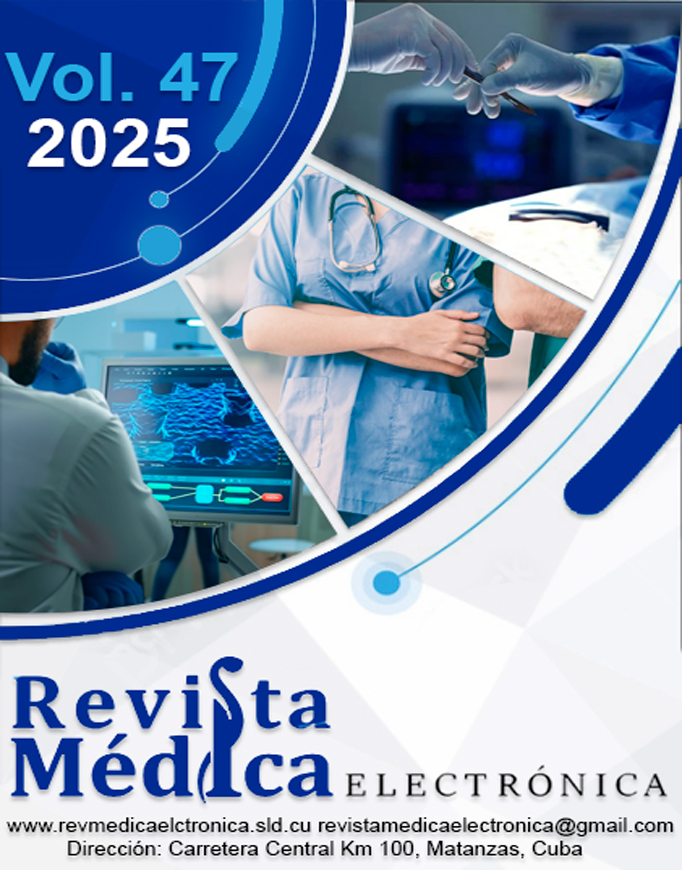Virtual didactic strategy to improve scientific writing in university students of Biochemistry and Pharmacy
Keywords:
didactic strategy; virtual platforms; scientific writing; university students; healthAbstract
Introduction: Didactic strategies in virtual environments are defined as a set of teaching activities aimed at online student learning, in order to achieve diverse educational objectives, which may include scientific writing as a fundamental research competence.
Objective: To evaluate a didactic strategy based on virtual platforms to improve scientific writing in university students of Biochemistry and Pharmacy.
Methods: A sample of 82 university students of Biochemistry and Pharmacy is studied, classified in two independent groups with an initial homogeneous performance in three dimensions of writing (precision, clarity, and brevity). The experimental group is intervened with a virtual didactic strategy in 11 months of training, while the control group maintains its traditional teaching-learning process.
Results: The students in their initial performance showed a low level in the three dimensions (82.93% with scarce competences), which improved significantly as part of the post-test in the three dimensions analyzed (0% to 93.68% with a high level; p=0.001).
Conclusions: It is evident that the students in the experimental group achieved a considerable advance using digital tools to optimize academic and scientific writing processes, in terms of coherence and semantics.
Downloads
References
1. Artioli G, Deiana L, De Vincenzo F, et al. Health professionals and students’ experiences of reflective writing in learning: A qualitative meta-synthesis. BMC Med Educ. 2021;21(1). DOI: 10.1186/s12909-021-02831-4.
2. Williams D. Writing skills in practice: A practical guide for health professionals. London: Jessica Kingsley Publishers; 2001.
3. Trujillo Rodríguez A, Casar Espino L, Muñoz Morejón M. Estrategia didáctica para el desarrollo, en entornos virtuales, de la redacción científica en inglés. Ser cient Univ cienc inform [Internet]. 2022 [citado 15/07/2024];15(12):165-82. Disponible en: https://publicaciones.uci.cu/index.php/serie/article/view/1232
4. Sagarra-Romero L, Ruidiaz Peña M, Monroy Antón A, et al. ithlete Heart Rate Variability app: knowing when to train. Br J Sports Med. 2017;51(18):1373-4. DOI: 10.1136/bjsports-2016-097303.
5. Liu ZY, Lomovtseva N, Korobeynikova E. Online learning platforms: Reconstructing modern higher education. J Emerg Technol Learn [Internet]. 2020 [citado 16/07/2024];15(13):4-21. Disponible en: https://www.learntechlib.org/p/217605/
6. Gadea-Uribarri H, Lago-Fuentes C, Bores-Arce A, et al. External Load Evaluation in Elite Futsal: Influence of Match Results and Game Location with IMU Technology. J funct morphol kinesiol. 2024;9(3):140. DOI: 10.3390/jfmk9030140.
7. Calero-Morales S, Vinueza-Burgos GC, Yance-Carvajal CL, et al. Gross motor development in preschoolers through conductivist and contructivist physical-recreational activities: Comparative research. Sports. 2023;11(3):61. DOI: 10.3390/sports11030061.
8. Concepción Obregón T, Fernández Lorenzo A, Matos Rodríguez A, et al. Habilidades profesionales de intervención clínica según modo de actuación de estudiantes de tercer año de Estomatología. Educ Méd Super [Internet]. 2017 [citado 16/07/2024];31(1):153-65. Disponible en: https://ems.sld.cu/index.php/ems/article/view/941
9. Game Mendoza KM, Vinueza Burgos GdC, Icaza Rivera DP, et al. Efectos de las estrategias colaborativas en el proceso académico de enseñanza-aprendizaje de voleibolistas prejuveniles. Retos. 2024;61:1172-83. DOI: 10.47197/retos.v61.109363.
10. Engeness I. Developing teachers’ digital identity: towards the pedagogic design principles of digital environments to enhance students’ learning in the 21st century. Eur J Teach Educ. 2021;44(1):96-114. DOI: 10.1080/02619768.2020.1849129.
11. Brown ME, Dueñas AN. A medical science educator’s guide to selecting a research paradigm: building a basis for better research. Med Sci Educ. 2020;30(1):545-53. DOI: 10.1007/s40670-019-00898-9.
12. Calero-Morales S, Villavicencio-Alvarez VE, Flores-Abad E, et al. Pedagogical control scales of vertical jumping performance in untrained adolescents (13–16 years): research by strata. PeerJ. 2024;12:e17298. DOI: 10.7717/peerj.17298.
13. Liu X, Wang X, Shi B, et al. Effect of Interdisciplinary Team Teaching on Postgraduate Students’ Beliefs and Confidence in Academic Writing. Creat Educ. 2022;13(9):2834-55. DOI: 10.4236/ce.2022.139179.
14. Krajčovič M, Gabajová G, Matys M, et al. Virtual reality as an immersive teaching aid to enhance the connection between education and practice. Sustainability. 2022;14(15):9580. DOI: 10.3390/su14159580.
15. Chao TC, Lin CH, Lee MS, et al. The Efficacy of Early Rehabilitation Combined with Virtual Reality Training in Patients with First-Time Acute Stroke: A Randomized Controlled Trial. Life. 2024;14(7):847. DOI: 10.3390/life14070847.
16. Daanish AF, Rahmani MR, Fawad SA, et al. The Impact of Real Prescription Examples on Prescription Writing Skills of Medical Students: A Quasi-Experimental Study. Res Sq. 2024. DOI: 10.21203/rs.3.rs-4191718/v1.
17. Castro-Rodríguez Y. Desarrollo de competencias investigativas en estudiantes de las Ciencias de la Salud. Sistematización de experiencias. Duazary. 2020;17(4):65-80. DOI: 10.21676/2389783X.3602.
18. Amat Abreu M, Velázquez MR, Cruz Velázquez D. Acciones metodológicas para mejorar la redacción científica en las formas de titulación en UNIANDES Puyo. Dilemas contemp educ política valores [Internet]. 2020 [citado 16/07/2024];8(1). Disponible en: https://dilemascontemporaneoseducacionpoliticayvalores.com/index.php/dilemas/article/view/2407
19. Armiñana-García R, Torres-Rivera RC, Fimia-Duarte R, et al. Estrategia de superación profesional para la elaboración y publicación de artículos científicos. Biotempo. 2021;18(2):145-58. DOI: 10.31381/biotempo.v18i2.4091.
20. Benoit Ríos CG. Argumentar y consensuar: dos habilidades fundamentales para la toma de decisiones en el aula. Universidad y Sociedad [Internet]. 2021 [citado 16/07/2024];13(3):9-20. Disponible en: http://scielo.sld.cu/scielo.php?pid=S2218-36202021000300009&script=sci_arttext&tlng=en
21. García-Giraldo J, González-Palacio L, González-Palacio M. Adaptación de los estilos de aprendizaje para cursos de ingeniería en una plataforma Learning Management System (LMS). RIST [Internet]. 2024 [citado 16/07/2024];E66:186-201. Disponible en: https://investigaciones-pure.udemedellin.edu.co/es/publications/adaptaci%C3%B3n-de-los-estilos-de-aprendizaje-para-cursos-de-ingenier%C3%AD
22. Baroudi S, Shaya N. Exploring predictors of teachers’ self-efficacy for online teaching in the Arab world amid COVID-19. Educ Inf Technol. 2022;27:8093-110. doi.org/10.1007/s10639-022-10946-4
23. Cando Almeida DA, Rivero Padrón Y. Estrategia de trabajo colaborativo mediante entornos virtuales para la redacción científica en la Universidad Israel. Universidad y Sociedad [Internet]. 2021 [citado 16/07/2024];13(3):38-49. Disponible en: http://scielo.sld.cu/scielo.php?pid=S2218-36202021000300038&script=sci_arttext&tlng=pt
24. De Sena A, Dettano A. Teaching and learning to conduct research in the virtual environment: evidence of consumption in the “Research Methodology” classroom. Res Educ Learn Innov. 2022;(29):43-58. DOI: 10.7203/realia.29.23785.
25. Sánchez MJ, Traver MT. Estudio de las estrategias de escritura científica utilizadas por investigadores noveles. Br J Ed Tech Soc. 2020;13(3):329-37. DOI: 10.14571/brajets.v13.n3.329-337.
Downloads
Published
How to Cite
Issue
Section
License
Copyright (c) 2025 Revista Médica Electrónica (Medical Electronic Journal)

This work is licensed under a Creative Commons Attribution-NonCommercial 4.0 International License.
All content published in this journal is Open Access, distributed under the terms of the CC BY-NC 4.0 License.
It allows:
- Copy and redistribute published material in any medium or format.
- Adapt the content.
This will be done under the following terms:
- Attribute the authors' credits and indicate whether changes were made, in which case it must be in a reasonable way.
- Non-commercial use.
- Recognize the journal where it is published.
The copyrights of each article are maintained, without restrictions.






